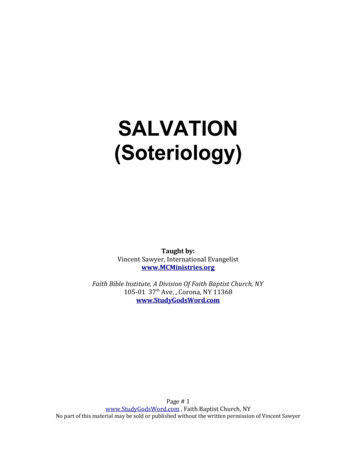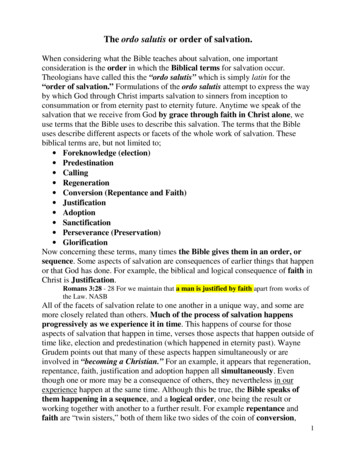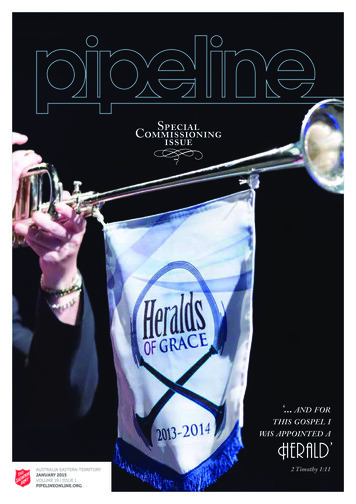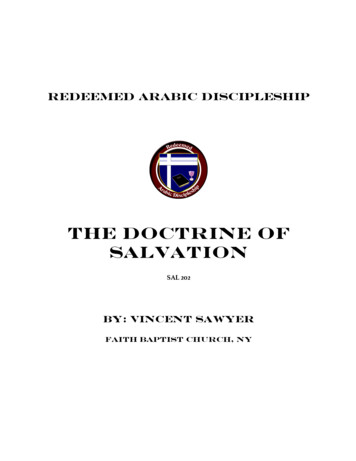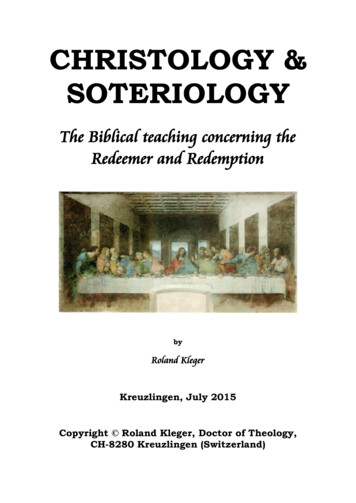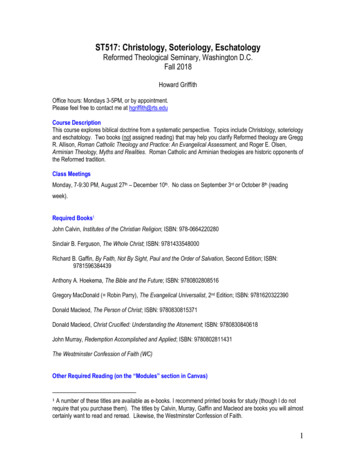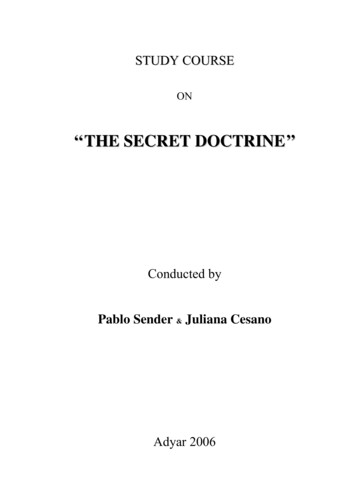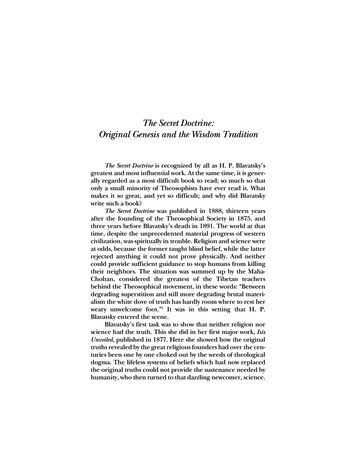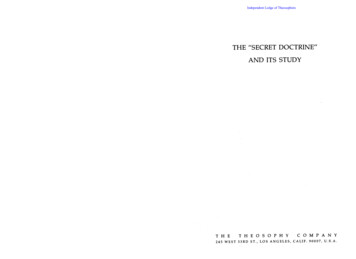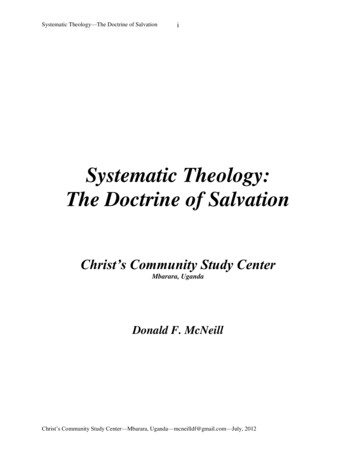
Transcription
Systematic Theology—The Doctrine of SalvationiSystematic Theology:The Doctrine of SalvationChrist’s Community Study CenterMbarara, UgandaDonald F. McNeillChrist’s Community Study Center—Mbarara, Uganda—mcneilldf@gmail.com—July, 2012
Systematic Theology—The Doctrine of SalvationiiThe Doctrine of Salvation—Table of ContentsI. IntroductionII. Biblical Argument for the Ordo Salutis—Order of SalvationA. John 3: 3-8B. 1 John 3: 9C. John 1: 12D. Ephesians 1: 13E. Romans 8: 30F. Romans 1: 17; 3:22, 26, 28, 30; 5: 1; Gal. 2: 16; 3: 24; Phil. 3: 9III. The Order of SalvationA. Effectual Calling1. Distinguished from Universal Call2. Effective unto Salvation because the Work of God3. The Meaning of Effectual CallingB. Regeneration1. The Meaning of Regeneration2. John 3: 1-8 and Ezekiel 36: 25-263. 1 John and the Relationship between Regenerationand ConversionC. Repentance and Faith (Conversion)1. Repentancea. The Meaning of Repentance—a change of mind .(1) .Concerning Sin(2) .Concerning God(3) .Concerning Ourselves(4) .Concerning Righteousnessb. The Necessity of Repentance2. Faitha. What Faith Is Notb. What Faith Is(1) Knowledge(2) Conviction or Assent(a) The Intellectual Element of Faith(b) The Emotional Element of Faith(3) Trustc. Assurance of FaithD. Justification1. Definition of Justification2. The Instrument of Justification—Faith3. The Confirmation of Justification—Good Works4. The Disposition of Justification—Prayer for Forgiveness5. The Importance of Justification by FaithE. Adoption1. Definition of Adoption2. The Pattern of God’s Relationship with His New CovenantPeopleChrist’s Community Study Center—Mbarara, Uganda—mcneilldf@gmail.com—July, 280281283283286287288288289289289
Systematic Theology—The Doctrine of Salvationiiia. Adoption Governs Our Conduct(1) Imitating the Father(2) Glorifying the Father(3) Pleasing the Fatherb. Adoption Governs Our Prayer Lifec. Adoption Governs the Life of Faith3. God the Father of Believers Only4. The Fatherhood of God in the Old TestamentF. Sanctification1. Definitive Sanctification2. Definitive Sanctification and Union with Christ—Romans 6:2-7:63. Progressive Sanctificationa. The Necessity of Progressive Sanctification—Indwelling Sin in the Believer (Rom. 7: 14-25)b. The Substance of Progressive Sanctification—Obedience to the Law of God andthe Fruit of the Spiritc. The Agents of Sanctification—The HolySpirit and the Believer(1) The necessity of the Holy Spirit(2) The Necessity of the Means of Grace(a) The word(b) Prayer(c) Fellowship with other believers(d) Participation in the Lord’s SupperG. Perseverance and Preservation1. The Believer’s Responsibility—Perseverance2. God’s Responsibility—PreservationH. Glorification1. Elements of Glorification2. The Time of Glorification—Romans 8: 18-25(a) The bondage of creation to man’s sin (vv. 20-21a)(b) The anxious longing of creation for its rebirth andfreedom at the revealing of the sons of God(vv. 19, 21b, 22)(c) The anxious longing of believers for the redemptionof their bodies (v. 23)(d) Perseverance in waiting (vv. 24-24)3. The Resurrection of the Body—1 Cor. 154. The Saints Glorified Together5. The Glorification of Christ in His Saints6. Our Proper Response to the Doctrine of GlorificationChrist’s Community Study Center—Mbarara, Uganda—mcneilldf@gmail.com—July, 331332332
Systematic Theology—Soteriology257Soteriology—The Doctrine of SalvationI. IntroductionOne may wonder why we need a separate study of the doctrine of salvation. After all, this iswhat we have been talking about all along in our study of Systematic Theology. Yet, the ways ofGod in saving His people need clarification so that we may better understand the working of theHoly Spirit (Pneumatology—also a separate topic for Systematic Theology) and the order ofevents involved in our salvation. In the accomplishment of redemption, all of the redemptiveevents do not occur at one time. God chose the line of Seth to be the progenitor of the godly lineof believers from Adam. He chose Noah to replenish the human race after the flood. He choseAbraham as the covenant head of the Jewish nation from whom would come the Messiah whowould give his life as an atonement for the believing remnant of Israel and for all who wouldhave a share in the faith of Abraham. Just as there are steps in the accomplishment ofredemption, there are also steps in the application of redemption.II. Biblical Argument for the Ordo Salutis—Order of SalvationIn his work, Redemption Accomplished and Applied, pp. 79-87, John Murray lays out a veryconvincing Biblical argument for a precise order of the application of redemption. Thefollowing discussion summarizes this argument and provides some additional observations.The application of redemption should not be thought of as “one simple and indivisible act”, butis a “series of acts and processes.” Theologians commonly use the following terms for thisseries: calling, regeneration, justification, adoption, sanctification, and glorification. These mayalso be divided further, or they may even be combined in some cases. We will leave theirprecise definitions for later. For now we are primarily concerned about the order in which theyoccur.One may question whether there is any benefit in determining their precise order since they areall components of a singular redemption. Are we not straining gnats from our tea to attempt todiscover how God applied redemption to the human heart? Two answers may be given to thisquestion. First, redemption is the crowning achievement of God, and is the antitype of thephysical creation of the world which is its type. We have no difficulty at all in gazing inwonderment at the physical creation with its magnitude of diversity and beauty. It is onecreation, but there are many parts to appreciate which the physical eyes can behold and scarcelymiss. On the other hand, the spiritual recreation in Christ (redemption) is not in the least senseinferior to the majesty and splendor of the creation of the world and is the end-goal to which thephysical creation points (Rom. 8: 18-25). As the types of the OT are always superseded in gloryby their NT antitypes, we may say that the new creation supersedes the physical creation insplendor and glory. But contrary to the visibility of the physical creation, the application ofredemption is invisible to the human eye and must be seen through the eyes of faith as theScriptures are unfolded. Second, the student will see from the following discussion thatScripture is not silent on the order of the application of redemption. A certain order of events iscertainly implied in Romans 8: 28-30, a passage which we will explore later, and if a certainorder is implied in Scripture, the Bible student is obligated to discern this order and the reasonfor it. To cast it aside nonchalantly (casually) as unimportant is to slight the Author ofChrist’s Community Study Center—Mbarara, Uganda—mcneilldf@gmail.com—July, 2012
Systematic Theology—Soteriology258redemption. As Murray insists, “God is not the author of confusion and therefore he is theauthor of order. There are good and conclusive reasons for thinking that the various actions ofthe application of redemption take place in a certain order, and that order has been establishedby divine appointment, wisdom, and grace” (p. 80).A. John 3: 3-8The seeing and entering of the kingdom of God mentioned by Jesus in His conversation withNicodemus certainly belong to the application of redemption. Without being born again(regeneration), one cannot enter this kingdom. It should be noticed that being born again islogically prior to seeing and entering this kingdom and is the precondition of the latter. Thesinner does not see and enter the kingdom of God (which we may call repentance and faith) inorder to be born again, but he is born again as the necessary precondition of seeing and entering.Thus, we may conclude that regeneration comes before repentance and faith. (More will be saidabout this passage later under the heading of regeneration.)B. 1 John 3: 9In this verse, being born of God is the necessary precondition of being delivered from the powerof sin (sanctification). This person cannot sin habitually as a way of life (the meaning implied inthe verb tense) “because he is born of God.” He is not delivered from the power of sin in orderto be born of God, but vice versa (the other way around). He is born of God in order to bedelivered from reigning sin in his life. The order of priority, then, is the new birth followed bythe process of sanctification. The practicality of this order is seen in people who wish to besaved by good works. If only they can improve their lives to some acceptable degree of purity,they will become Christians. The folly of this belief is obvious to any who understand theChristian faith. Moral improvement is impossible apart from the new birth.C. John 1: 12Two main ideas dominate this text: the reception of Christ and the bestowing of authority uponthose who receive Him. The reception of Christ is faith, and the bestowing of the authority tobecome the children of God is called adoption. The logical priority is the receiving of Christ byfaith followed by the adoption of the individual into the family of God—the bestowment ofauthority (“right”) to become the children of God. No one can be called a child of God withoutfirst receiving Christ by faith; therefore the one must come before the other.D. Ephesians 1: 13The logical order found in this passage is the hearing of the gospel followed by the believing ofthe gospel, after which the believing individual is sealed with the Holy Spirit of promise. Therecan be no sealing of the Spirit without the individual first having believed the gospel.Careful consideration of these texts should convince us that the divine order in the application ofredemption is based on exegesis (analysis of the texts) and not on “empty logic.”E. Romans 8: 30Christ’s Community Study Center—Mbarara, Uganda—mcneilldf@gmail.com—July, 2012
Systematic Theology—Soteriology259Three separate acts of the application of redemption are mentioned in this passage—calling,justification, and glorification, in that order. Do we know for sure that this order is intended bythe Apostle Paul, or could he just as well have mentioned these acts in a different order? Even ifjustification had been mentioned before calling, the main thought of the passage would have notbeen altered. The main thought of the passage is the connection of calling, justification, andglorification with the eternal purpose of God expressed in His foreknowledge and predestination(See also v. 29). What we see in this verse is an unbreakable chain of events which originates inthe foreknowledge of God and ends with the glorification of the Christian in heaven. Notice thatthere is none lost from the beginning of the process to the end. All those who are foreknown andpredestined are also called, justified, and glorified. There is absolutely no attrition (loss) ofChristians at any step in the process. We may ask, why?The reason is found earlier in the passage beginning with the intercession of the Spirit in vv. 26and 27. The Spirit is interceding for us with “groanings too deep for words.” But further, theblessings of calling, justification, and glorification which flow to the Christian in this passageconstitute an unbroken chain from cause to effect. The ultimate cause is God, or morespecifically, the purpose of God directed to all who love Him and are called according to Hispurpose. For these individuals, every single event of their lives is designed and ordered by Godto “work together for [their] good.” It is appropriate at this point to ask what this “good” is. Theanswer is not far away in v. 29 in which Paul says that all those who are foreknown by God arepredestined to be conformed to the image of His son. The “good”, then, is conformity to theimage of Christ, or sanctification, which is God’s purpose for everyone who loves Him and iscalled. And because of the connection between v. 29 and v. 30, we may safely assume that thosewho are foreknown and predestined in v. 29 are the same as those who love God and are calledaccording to His purpose in v. 28. There can be no distinction between the two without doingviolence to the text.Having stated the ultimate purpose of God for the believer, sanctification, Paul proceeds in v. 30to list some of the steps leading irreversibly and unimpeded (unstopped) to this purpose. All ofthe steps are not mentioned, only three. Nevertheless we are warranted (have reason) to believethat all the steps are comprehended (included) by the apostle in these three. When we study thesteps in the ordo salutis (order of salvation) in detail, we will appreciate the logical orderpresented here. The last step mentioned is glorification, which is the comprehensive (includingall the parts) goal and completion of God’s purpose in sanctification. In glorification, thesanctifying process which begins at justification will be brought to completion, and the Christianwill perfectly reflect the moral image of Jesus Christ without defect.We learn from this text that the purpose of God for every believer comes before our calling,justification, and glorification and serves as the “pattern” by which these three acts take place.We may think of God’s purpose, which is expressed in foreknowledge and predestination, as theblueprint and plans of a building while calling, justification, and glorification is the buildingitself. The building is constructed in accordance to the blueprint and not vice versa (the otherway around). The blueprint is not drawn up after the building is completed but long before, andit gives direction to the intricate details of the building’s construction. In the same way, God isconstructing the life of every believer according to His foreknowledge and predestinatingpurpose to make the believer holy as He Himself is holy. To continue the analogy, when theChrist’s Community Study Center—Mbarara, Uganda—mcneilldf@gmail.com—July, 2012
Systematic Theology—Soteriology260shell of a building is first constructed, it doesn’t look very pretty. The floors are bare and dirtyfrom construction materials. Plumbing pipes and electrical wires are exposed and danglingeverywhere with no seeming purpose. The building is unpainted and unfinished. But when thefinishing touches are applied, its glory is finally unveiled. There is much about our lives whichdoesn’t look too pretty, and the lives of those who come to Christ later in life look like a dirtyconstruction zone much of their time on earth. Nevertheless, God’s predestinating purpose (theblueprint) is being carried out on schedule for this particular individual and will not be frustrated.When God starts building, He never has to stop due to lack of funds or ability (Phil 1: 6).Throughout our lives on earth, He will be continuing this building and improving it, and it willnever be completed in this life. But when we die and go to be with the Lord in heaven, He willput His finishing touches on it, and it will be perfect and glorified. The Apostle John assures us,“Beloved, now we are children of God, and it has not appeared as yet what we shall be. Weknow that, when He appears, we shall be like Him, because we shall see Him just as He is (1 Jn.3: 2).Thus far we have not established the fact that calling comes before justification, but sinceforeknowledge and predestination are considered first and glorification last, we are justified insaying that Paul would not waver (go back and forth) from the logical order which he has begunin the passage. Calling comes before justification.F. Romans 1: 17; 3:22, 26, 28, 30; 5: 1; Gal. 2: 16; 3: 24; Phil. 3: 9The Biblical record testifies that “we are justified by faith, from faith, through faith, and uponfaith.” It should be noted that the word “justify” and “righteousness” in the Greek language aretaken from the same root word. To justify the sinner is simply to make him righteous or todeclare him to be righteous before God. If faith is the instrument through which or by whichGod declares one to be righteous or justified, then it would naturally follow that faith is prior tojustification. If justification comes before faith, then Paul should say that faith comes through orby justification and not that justification is by faith.Another reason Murray gives for putting faith before justification is that calling comes beforejustification (per Rom. 8: 30). This calling is the divine call of God to the sinner by means of theHoly Spirit through which He woos and persuades the sinner to come to Him in faith. (Moreabout calling will come later in our discussion). Faith is the response of the sinner to this calling.Although it is not the same thing as calling, its connection with calling is inevitable because ofthe sovereign will of God in producing the desired result of faith. Therefore, because of thisimmediate and inevitable connection between calling and faith, and because calling is beforejustification, then faith must also come before justification.Thus far in the order of the application of redemption, we have calling, faith, justification, andglorification. Where does regeneration (being born again) fit into this scheme? Does it comebefore calling? Though he recognizes arguments which could be used in favor of regenerationcoming before calling, Murray places it after calling. He does not present a specific proof text,but argues that the emphasis in Scripture is placed upon calling “as that act of God wherebysinners are translated from darkness to light and ushered into the fellowship of Christ.” It is inGod’s sovereign call of the sinner from darkness to light which marks the beginning of salvation“in actual possession,” thus the priority of order is given to the call and not to regeneration.Christ’s Community Study Center—Mbarara, Uganda—mcneilldf@gmail.com—July, 2012
Systematic Theology—Soteriology261(More will be said about this later, but it should be noted that the Westminster Confession ofFaith treats calling and regeneration together and not separately.)So then, we now have calling, regeneration, faith, justification, and glorification. “The othersteps [in the ordo salutis] can be readily filled in and put in their proper place. Repentance is thetwin sister of faith—we cannot think of the one without the other, and so repentance would beconjoined [put together] with faith. Conversion is simply another name for repentance and faithconjoined and would therefore be inclosed in repentance and faith.” Thus we now have calling,regeneration, conversion (or repentance and faith together), justification, and glorification.To this sequence we add adoption, the bestowing of authority to become the children of God.From John 1: 12 we concluded that adoption must come after receiving Christ by faith. (See thatdiscussion above.) The question would be whether adoption would come before justification orafter justification. The logical order would be justification before adoption for the simple reasonthat one cannot be adopted into the family of God before he is accepted by God as forgiven.Murray gives no specific text in proof of this order, but one can be found if we accept the logicaland exegetical implications of the text. In Romans 5: 1 Paul proclaims, “Therefore having beenjustified by faith, we have peace with God through our Lord Jesus Christ.” As we have seenfrom this text, faith comes before justification and is the instrumental means of justification. Theverb form, “having been justified” is an aorist participle which most likely functions as aninstrumental participle indicating “the means by which the action of the main verb isaccomplished (Dana and Mantey, A Manual Grammar of the Greek New Testament, p.228). Themain verb in the sentence is the verb “have.” We may translate the verse accordingly,“Therefore by means of having been justified by faith, we have peace with God through our LordJesus Christ.” This construction sounds awkward, but the more precise meaning is conveyed byit. We learn further that the aorist tense of the participle in this verse indicates “antecedentaction relative to the main verb ” (Dana and Mantey, p.230). In other words, the action ofbeing justified comes before the action of the main verb, having peace with God. We arelogically consistent to assume that having peace with God is one aspect of the benefits ofadoption. God does not adopt someone into His family with whom He is still at war. Thus, weare first justified (declared righteous by God) and then adopted into His family as those who areat peace with God.It is arguable that adoption is the highest privilege of God’s people (See J. I. Packer, KnowingGod, p. 186, quoted in Henry Krabbendam, unpublished class notes on “Christian Doctrine”, p.123). Indeed, as Packer points out, the new covenant name for God is “Father”, and ourrelationship to God as our father is a good measure of our understanding of the Christian faith(pp. 181-186). It follows then, that the sonship implied in adoption is not merely a step in theorder of salvation, but the very foundation of everything else which follows—sanctification,perseverance, and glorification. As sons, we are sanctified (set apart) for the special privilege ofbeing disciplined by a loving father who knows what is best for His children. We perseverebecause our Father cannot cast off His children, and He will not allow us to fall away and beeternally lost. By the same reasoning our glorification is certain because as sons of God we arepredestined to share in the inheritance of Jesus Christ with Whom we are united.Christ’s Community Study Center—Mbarara, Uganda—mcneilldf@gmail.com—July, 2012
Systematic Theology—Soteriology262Although it is difficult to place adoption, it appears that the only likely place to put it is afterjustification and before sanctification. Thus we now have calling, regeneration, conversion(repentance and faith), justification, adoption.This leaves us with the placement of sanctification which is the process whereby the believer isbrought into conformity with the moral perfection of Christ. Sanctification can be subdividedinto definitive sanctification and progressive sanctification (See John Murray, CollectedWritings, Vol. 2, chapters 21 and 23). “Sanctification is a process that begins in regeneration,finds its basis in justification, and derives its energizing grace form the union with Christ whichis effected in effectual calling. Being a continuous process rather that a momentary act likecalling, regeneration, justification and adoption, it is proper that it should be placed afteradoption in the order of application” (Redemption Accomplished and Applied, p. 87). In otherwords, while definitive sanctification is present in regeneration as the believer is “set apart” forholiness, this sanctification is not complete in regeneration but continues throughout his life asprogressive sanctification until he is completely glorified (entirely sanctified). It is inprogressive sanctification after adoption that the believer receives the primary benefits of theFather’s care in which He disciplines the believer as a father disciplines his son. Discipline is themain subject of the first half of Heb. 12 which finds its purpose in the experiential sanctificationof the believer. It could accurately be said that sanctification, as God’s ultimate purpose for thebeliever, permeates (spreads through) the entire order of salvation from regeneration toglorification. It is so important that we will spend considerable time on the subject later.Perseverance, the continuation of the believer in faith, repentance, and obedience, occurs at thesame time as progressive sanctification and serves to complete the meaning if sanctification.Thus considered, it “might conveniently be placed either before or after sanctification.” Thisleaves us one concept, union with Christ, which is not an actual step in the application ofredemption, but rather “the central truth of the whole doctrine of salvation not only in itsapplication but also in its once-for-all accomplishment in the finished work of Christ”(Redemption Accomplished and Applied, p. 161). As such, union with Christ “underlies everystep of the application of redemption.”The order of salvation (order of the application of redemption) as we shall discuss it in thefollowing pages is then:1. Calling2. Regeneration3. Repentance and Faith (conversion)4. Justification5. Adoption6. Sanctification7. Perseverance and Preservation8. GlorificationUnion with Christ underlines all eight of these steps but will be covered only in conjunction withsanctification (cf. p. 324).III. The Order of SalvationChrist’s Community Study Center—Mbarara, Uganda—mcneilldf@gmail.com—July, 2012
Systematic Theology—Soteriology263A. Effectual CallingQuestion 31 of the Westminster Shorter Catechism asks the question: What is effectual calling?The answer it gives to this question is the following: “Effectual calling is the work of God’sSpirit, whereby, convincing us of our sin and misery, enlightening our minds in the knowledge ofChrist, and renewing our wills, he doth persuade and enable us to embrace Jesus Christ freelyoffered to us in the gospel.”1. Distinguished from Universal CallThe terms which are used are significant—effectual calling. In being effectual, it is distinguishedfrom the universal call of the gospel in which even the non-elect hear the message of salvation(Matt. 22: 14), but are not convinced of their sin or of their need for salvation. The gospel ispreached to millions each year, many of them who are members of evangelical churches, uponwhom it has no positive effect, only the negative effect of hardening those who hear it (2 Cor. 2:15-16; Rom. 9: 17-18). Pharaoh heard the OT message of the gospel from Moses, who pleadedwith him to submit to Yahweh and let the people of Israel worship Him. He hardened his ownheart to this plea, and God hardened his heart further. One can never hear the gospel without ithaving an impact upon his life. The gospel is the Word of God, and God has said that His wordwill always accomplish His intentions—whether life or death (Isa. 55: 11). In this sense, eventhe universal call of God is “effectual”—it is effectual for the hardening of the heart for thosewho reject it (See also Krabbendam, pp. 124-125). Krabbendam departs from the traditionalview of universal calling and effectual calling, maintaining that there is only one calling of Godwith two effects. The effectual calling of the elect to salvation is the same in substance as theeffectual calling of the non-elect which hardens them to the gospel. “In summary, while all thecalled are not chosen (Matthew), all the chosen are called (Romans). It should be evident thatthis does not logically imply that the non-elect are never the recipients of what the Bibledesignates as ‘calling.’” The problem I have with Krabbendam’s view is the emphasis this viewmust place upon the passage in Matt. 22: 14, “For many are called, but few are chosen.” Thecontribution of this passage to the subject of calling is minimal compared to the predominance ofpassages which almost invariably treat calling as the effectual call to salvation. Murray’scomments are well taken.But it is very striking that in the New Testament the terms for calling, when used specifically with reference tosalvation, are almost uniformly applied, not to the universal call of the gospel, but to the call that ushers meninto a state of salvation and is therefore effectual. There is scarcely an instance where the terms are used todesignate the indiscriminate overture of grace in the gospel of Christ. Hence the all but uniform meaning isthat which is fixed by such well-known passages as Romans 8: 30 .(Murray, p. 88, emphasis mine).Another problem is that this view would seem to make the calling mentioned in Romans 8: 30superfluous (unnecessary) since everyone, non-elect included, is called. If the calling in thispassage applies to the non-elect as well as the elect, why bother to include it in the unbrokenchain of redemption?Returning to the traditional view, in the universal call of the gospel, the gospel is preached to allmen and women because Christ has told us to do so (Lk. 24: 46-47) regardless of the response.The responsibility of being successful in this endeavor is not ours, but belongs to God. Ourresponsibility is simply to explain the message of the gospel as clearly and accurately as we canand leave the results up to God. We are sent to preach the gospel, not in “cleverness of speech”Christ’s Community Study Center—Mbarara, Uganda—mcneilldf@gmail.com—July, 2012
Systematic Theology—Soteriology264(1 Cor. 1: 17), that is, not with human wisdom. We are not sent to sell anything (2 Cor. 2: 17) asif the gospel were for sale. Salvation is free to all who accept it, and we need not withhold thetruth about man’s sin, misery, and the consequences of unbelief, to make the gospel moreappealing to resistant hearts. Only God can open men’s hearts, and none of our efforts to “sell”the gospel will make our preaching more successful in actually drawing men to the Savior. Suchtactics will only fill the churches with people who are “saved” on the throne of their own selfwill and idolatry. They will be “Christians” in name only and will serve only to be a thorn in theflesh of the preacher and a discouragement to church members who truly know Jesus Christ.2. Effective unto Salvation because the Work of GodEffectual call, then, is distinguished from universal call. It is effectual in that it actuallyaccomplishes the design of drawing people to Christ. Jesus said, “No one can come to Me unlessthe Fa
Effective unto Salvation because the Work of God 264 3. The Meaning of Effectual Calling 264 B. Regeneration 266 1. The Meaning of Regeneration 266 2. John 3: 1-8 and Ezekiel 36: 25-26 268 3. 1 John and the Relationship between Regeneration and Co
